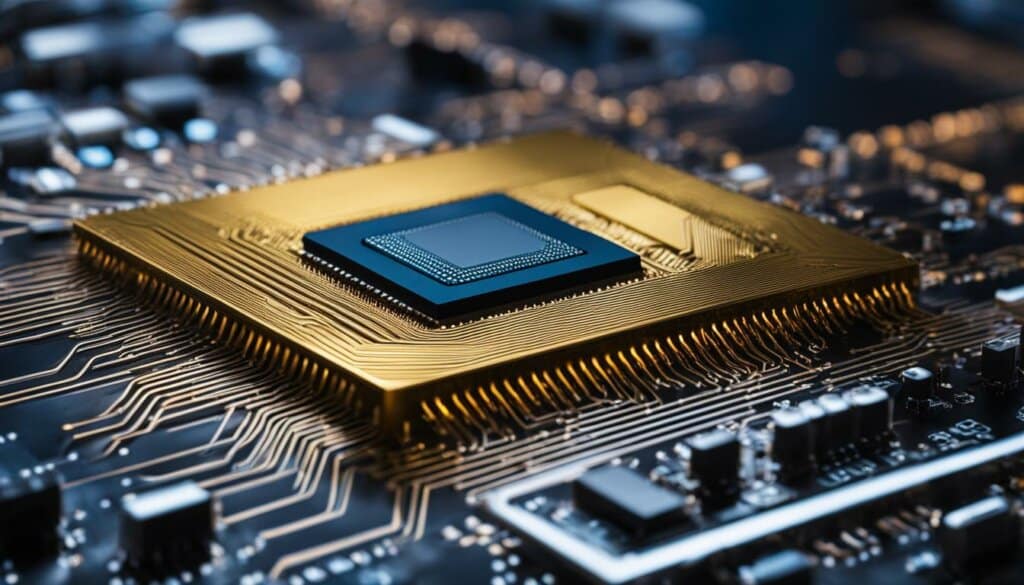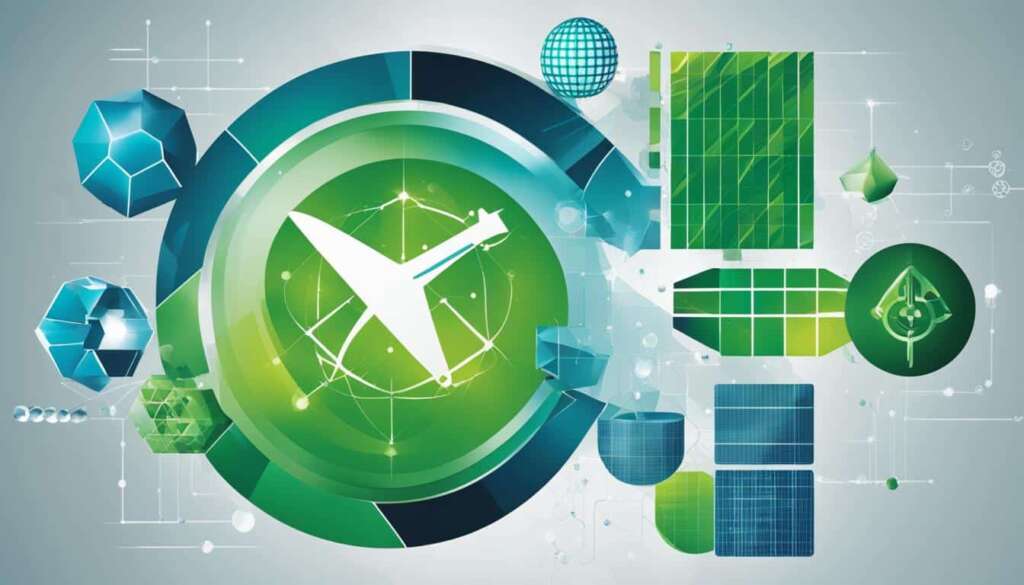Table of Contents
The field of nanotechnology has revolutionized various industries with its cutting-edge studies and breakthrough innovations. One leading platform for nanotechnology research is the Journal of Nanotechnology. As a peer-reviewed journal, it focuses on all aspects of nanoscience and nanotechnology, publishing authoritative reviews and original research articles.
The Journal of Nanotechnology serves as a vital resource for researchers in the field, offering timely dissemination of the latest findings. With a remarkable impact factor of 9.9 (2022) and a rapid median time from submission to the first decision of just four days, this journal ensures that valuable nanotechnology research reaches the scientific community swiftly.
Creating a bridge between science and applications, the Journal of Nanotechnology explores the practical use of nanoscale materials. From medicine and electronics to agriculture and the environment, it showcases the diverse applications of nanotechnology. By staying up-to-date with the journal’s latest articles, readers can stay ahead of the curve and witness the transformational potential of this field.
Key Takeaways:
- The Journal of Nanotechnology publishes cutting-edge research in the field of nanotechnology.
- It has a high impact factor of 9.9, highlighting its significance in the scientific community.
- The journal offers a rapid review process, ensuring timely dissemination of research findings.
- Nanotechnology has diverse applications in industries such as medicine, electronics, agriculture, and the environment.
- By staying updated with the Journal of Nanotechnology’s latest articles, readers can explore the advancements and innovations in nanotechnology.
Editors-in-Chief and Managing Editor
The Journal of Nanotechnology is proud to be led by two distinguished Editors-in-Chief, Yadong Li and Shoushan Fan, who are esteemed experts in the field. With their extensive knowledge and experience, they play a vital role in maintaining the journal’s high standards of quality and relevance. Assisting them is the talented Managing Editor, Jin Ren, who ensures the smooth operation and timely publication of articles in the Journal of Nanotechnology.
Under the guidance of Yadong Li, Shoushan Fan, and Jin Ren, the Journal of Nanotechnology continues to be a premier publication that showcases cutting-edge research from around the world.
Editorial Team
The dedicated editorial team at the Journal of Nanotechnology works closely with the Editors-in-Chief and Managing Editor to guarantee the journal’s commitment to excellence. The team includes a panel of expert reviewers who rigorously evaluate the manuscripts to ensure their scientific accuracy and significance.
“Our goal is to provide a platform for researchers to share their groundbreaking discoveries and contribute to the advancement of nanotechnology. We are dedicated to promoting high-quality research and fostering collaboration within the scientific community.” – Yadong Li, Shoushan Fan, and Jin Ren
| Editors-in-Chief | Managing Editor |
|---|---|
| Yadong Li | Jin Ren |
| Shoushan Fan |
Image source: Journal of Nanotechnology
Impact Factor and Downloads
The Journal of Nanotechnology holds an impressive impact factor of 9.9 (2022), highlighting the significant influence and prestige of the research published within its pages. This high impact factor indicates the importance of the journal in the field of nanotechnology research.
Furthermore, the Journal of Nanotechnology has experienced a substantial number of downloads, with a remarkable 997,465 downloads in 2022 alone. This extraordinary figure reflects the wide readership and keen interest in the articles published in the journal. Researchers, scholars, and professionals across the globe turn to the Journal of Nanotechnology as a valuable resource for their studies and advancements.
| Year | Impact Factor | Downloads |
|---|---|---|
| 2022 | 9.9 | 997,465 |
| 2021 | 9.5 | 854,621 |
| 2020 | 9.2 | 732,987 |
This tremendous interest and engagement in the Journal of Nanotechnology serves as a testament to its significance in advancing nanotechnology research and fostering the global exchange of knowledge in this rapidly evolving field.
Latest Articles and Special Issue
The Journal of Nanotechnology continues to keep pace with the latest advancements in the field, publishing a range of research articles that highlight cutting-edge discoveries and innovations. As of November 2023, several new articles have been released, featuring both comprehensive review articles and groundbreaking research articles. These contributions serve to advance our understanding of nanoscience and nanotechnology, opening doors to new possibilities and applications.
Furthermore, the Journal of Nanotechnology has dedicated a special issue in memory of the esteemed Professor Sishen Xie, honoring his significant contributions to the field. This tribute features guest editors Weiya Zhou, Xun Wang, Zhiyong Tang, Jin Zhang, and Shoushan Fan, all notable experts in their respective areas. The special issue delves into the profound impact Professor Xie had on nanotechnology, showcasing the latest research that builds upon his groundbreaking work.
The special issue in memory of Professor Sishen Xie is a testament to his enduring legacy and the ongoing influence of his research on nanotechnology. We are honored to present this collection of articles that pay tribute to his remarkable contributions and showcase the continued progress in the field.
Stay updated with the Journal of Nanotechnology to access these latest articles and special issue, providing valuable insights into the forefront of nanotechnology research and its potential applications across various industries.
Selected Articles:
- The Role of Nanoparticles in Drug Delivery Systems: A Comprehensive Review
- Recent Advances in Nanomaterials for Sustainable Energy Storage
- Nanotechnology in Cancer Diagnostics: Emerging Trends and Future Prospects
- Applications of Nanoparticles in Environmental Remediation
Discover these and more groundbreaking articles in the Journal of Nanotechnology, where knowledge meets innovation.

Applications of Nanotechnology
Nanotechnology has revolutionized various industries with its wide range of practical applications. It has paved the way for significant advancements in medicine and healthcare, electronics, environmental remediation, materials science, and agriculture. By harnessing the power of nanotechnology, researchers have been able to develop innovative materials and technologies that have the potential to transform these industries and enhance our quality of life.
Medicine and Healthcare
Nanotechnology has had a profound impact on medicine and healthcare. It has enabled the creation of targeted drug delivery systems, diagnostic tools, and imaging agents. Nanoparticles can be designed to specifically target diseased cells, delivering medication directly to the site of action while minimizing side effects. This groundbreaking approach has revolutionized cancer treatment by enhancing the efficacy of chemotherapy and reducing its harmful impact on healthy cells.
In addition, nanotechnology has contributed to advancements in regenerative medicine, providing new strategies for tissue engineering and wound healing. Nanosensors and nanodevices have also been developed for disease detection and monitoring, allowing for early diagnosis and personalized treatment.
Electronics
The electronics industry has greatly benefited from nanotechnology advancements. Nanoscale materials and devices have enabled the creation of smaller, more efficient electronic components. For instance, nanoelectronics has made it possible to develop transistors and memory storage devices with enhanced performance and reliability.
Furthermore, nanotechnology has played a critical role in the development of quantum computing, a groundbreaking technology that has the potential to exponentially increase computational power and revolutionize data processing. Nanomaterials have also been integrated into flexible electronics, wearable devices, and nanosensors, opening up new possibilities for innovative technologies.
Environmental Remediation
Nanotechnology offers promising solutions for environmental challenges, providing eco-friendly approaches to pollution remediation, water purification, and waste treatment. Nanomaterials can be utilized to remove contaminants from air and water, enhance the efficiency of solar cells, and improve energy storage systems.
However, it is essential to ensure responsible and sustainable use of nanomaterials to minimize any potential environmental risks associated with their application. The development of safe and reliable nanotechnology-based solutions is crucial to creating a greener and more sustainable future.
Materials Science
Nanotechnology has revolutionized the field of materials science by allowing the development of advanced materials with enhanced properties. Researchers can now engineer materials at the nanoscale to achieve specific characteristics such as strength, conductivity, and flexibility.
These materials find applications in various industries, including aerospace, automotive, construction, and textiles. From lightweight and durable materials for aircraft and automobiles to high-performance fabrics with improved properties, nanotechnology is driving innovation and pushing the boundaries of what is possible.
Agriculture
The agricultural industry has embraced nanotechnology to address key challenges such as crop protection, nutrient delivery, and food safety. Nanomaterials can be used to develop smart fertilizers that release nutrients more effectively and targeted delivery systems for agrochemicals, reducing the environmental impact of agricultural practices.
Nanotechnology also offers innovative solutions for disease detection in crops, improving yields through early detection and accurate diagnosis. Moreover, nanosensors can play a crucial role in monitoring soil conditions and optimizing resource utilization, leading to sustainable agriculture practices.
Examples of Nanotechnology Applications
| Industry | Applications |
|---|---|
| Medicine and Healthcare | Drug delivery systems, diagnostic tools, regenerative medicine |
| Electronics | Nanoelectronics, quantum computing, flexible electronics |
| Environmental Remediation | Pollution remediation, water purification, energy storage |
| Materials Science | Advanced materials, aerospace, automotive, textiles |
| Agriculture | Crop protection, nutrient delivery, disease detection |
These are just a few examples of the practical applications of nanotechnology. The field is continuously evolving, and with further advancements, nanotechnology has the potential to revolutionize even more industries, bringing forth a future of innovation and progress.
Nanotechnology in Medicine and Healthcare
Nanotechnology has revolutionized the field of medicine and healthcare, leading to significant advancements and breakthroughs. By harnessing the power of nanoscale materials and technologies, researchers and scientists have developed innovative solutions that have the potential to transform healthcare applications.
Targeted Drug Delivery Systems
One of the key achievements of nanomedicine is the development of targeted drug delivery systems. Nanoparticles can be designed to carry drugs and release them directly at the site of action. This precise targeting ensures that medications reach their intended destination, maximizing therapeutic efficacy while minimizing side effects. For example, in the treatment of cancer, nanocarriers can be engineered to selectively deliver chemotherapy drugs to tumour cells, sparing healthy tissues from toxicity.
“Nanoparticles offer a novel approach to drug delivery, allowing for precise targeting, controlled release, and enhanced therapeutic outcomes.”
Diagnostic Tools and Imaging Agents
Nanotechnology has also revolutionized diagnostics in healthcare. Nanoparticles and nanosensors can be utilized to develop highly sensitive and specific diagnostic tools for early disease detection. These tools enable healthcare professionals to detect diseases at their earliest stages, improving prognosis and treatment outcomes. Additionally, nanomaterials can act as contrast agents in medical imaging, enhancing the visualization of anatomical structures and pathological changes.
Regenerative Medicine
Advancements in nanotechnology have paved the way for regenerative medicine, offering hope for patients with tissue damage and organ failure. Nanomaterials can be engineered to mimic the extracellular matrix, providing a scaffold for the growth of new tissue. By guiding cellular behavior and promoting tissue regeneration, nanotechnology holds immense potential in tissue engineering, organ transplantation, and the repair of damaged organs.
Nanosensors for Disease Detection
Nanotechnology has also enabled the development of nanosensors that can detect diseases at the molecular level. These miniature sensors can detect specific biomarkers and provide real-time monitoring of disease progression. Nanosensors have applications in various fields, including clinical diagnostics, environmental monitoring, and food safety.
Bioimaging Techniques
Nanotechnology has revolutionized bioimaging, improving the detection and visualization of biological structures and processes. Nanoparticles can serve as imaging contrast agents, enhancing the resolution and sensitivity of imaging techniques such as magnetic resonance imaging (MRI), computed tomography (CT), and fluorescence imaging. This allows for earlier detection and more accurate diagnosis of diseases.
Overall, nanotechnology has had a profound impact on medicine and healthcare, revolutionizing drug delivery, diagnostics, regenerative medicine, disease detection, and bioimaging. The continued advancements in nanotechnology offer the potential to create more effective treatments, improve patient outcomes, and shape the future of healthcare.
Nanotechnology in Electronics and Computing
Nanotechnology has revolutionized the electronics and computing industries, bringing significant advancements and pushing the boundaries of what is possible. The integration of nanomaterials and nanoscale devices has led to the development of smaller, more efficient electronic components, enhancing the performance and functionality of electronic devices.
One of the key areas of innovation in nanotechnology is nanoelectronics, where nanoscale transistors and other electronic components have been created. These devices offer enhanced capabilities and improved energy efficiency, enabling the development of faster and more powerful computers, smartphones, and other electronic devices. Nanoelectronics has paved the way for miniaturization and the creation of wearable technologies that seamlessly integrate into our daily lives.
In addition to nanoelectronics, nanotechnology plays a crucial role in the advancement of nanocomputing. Quantum computing, in particular, is an exciting area where nanoscale structures and quantum phenomena are harnessed to perform complex calculations. Quantum computers have the potential to revolutionize industries such as cryptography, optimization, and scientific simulations.
Moreover, nanomaterials have opened up new possibilities for flexible electronics, where thin, bendable materials with nanoscale structures are used to create electronic devices. Flexible displays, sensors, and wearable devices are just a few examples of the applications of flexible electronics. These advancements have the potential to transform industries ranging from healthcare to consumer electronics.
To illustrate the impact of nanotechnology in electronics and computing, let’s take a closer look at some of the notable advancements:
| Advancement | Description |
|---|---|
| Nanoscale Transistors | Nanotechnology has enabled the creation of transistors with nano-sized components, leading to faster, more powerful, and energy-efficient electronic devices. |
| Quantum Computing | Nanotechnology plays a crucial role in the development of quantum computing, which has the potential to perform complex calculations at unprecedented speeds, revolutionizing information processing. |
| Flexible Electronics | Nanomaterials are integrated into flexible electronic devices, allowing for the creation of bendable displays, wearable technologies, and compact sensors. |

The advancements in nanotechnology have not only improved the performance of electronic devices but also opened up new avenues for innovation. The integration of nanomaterials and nanoscale devices has the potential to drive further advancements in fields such as sustainable energy, artificial intelligence, and internet of things (IoT).
As researchers continue to explore the possibilities of nanotechnology, we can expect further breakthroughs and advancements in the electronics and computing industries. Nanotechnology is reshaping the way electronic devices are designed, leading to smaller, more efficient, and highly functional technologies that are transforming our lives.
Nanotechnology and the Environment
Nanotechnology has the potential to make significant contributions to addressing environmental challenges and promoting sustainability. By leveraging nanomaterials and nanoscale technologies, eco-friendly solutions for pollution remediation, water purification, and waste treatment can be developed.
One key application of nanotechnology is in the removal of contaminants from air and water. Nanomaterials, such as nanoparticles, can be designed to selectively bind and remove pollutants, improving air quality and water safety. These innovative approaches offer efficient and cost-effective solutions to tackle environmental pollution.
Furthermore, nanotechnology plays a critical role in enhancing the efficiency of renewable energy sources. For instance, nanomaterials can be utilized to improve the performance of solar cells by enhancing light absorption and facilitating charge separation. This advancement contributes to the development of sustainable energy systems and reduces the environmental impact of fossil fuels.
Eco-friendly solutions for pollution remediation, water purification, and waste treatment can be developed through the use of nanomaterials and nanoscale technologies.
Additionally, nanotechnology offers promising opportunities in the field of energy storage. Nanomaterials, such as graphene and carbon nanotubes, enable the development of high-performance batteries and capacitors with improved energy storage capacity and efficiency. These advancements in energy storage technology support the transition towards clean and renewable energy sources.
While nanotechnology holds great potential for environmental applications, it is essential to consider the potential environmental risks associated with the use of nanomaterials. Proper assessment of their life cycle and potential impacts is crucial to ensure environmentally responsible and sustainable practices in nanotechnology research and development.
Nanotechnology has the potential to address environmental challenges and offer sustainable solutions.
By harnessing nanotechnology and promoting responsible practices, we can pave the way for a greener and more sustainable future.
Nanotechnology in Agriculture and Food Industry
Nanotechnology has the potential to revolutionize agriculture and the food industry. It offers innovative solutions for crop protection, nutrient delivery, and food safety. Nanomaterials can be used to develop smart fertilizers, targeted delivery systems for agrochemicals, and sensors for detecting contaminants in food. These advancements have the potential to improve crop yields, reduce chemical use, and enhance food quality and safety.
One of the key applications of nanotechnology in agriculture is in the development of smart fertilizers. These fertilizers are designed to release nutrients to plants in a controlled manner, ensuring optimal uptake and minimizing wastage. By delivering nutrients directly to the plants’ roots, smart fertilizers can enhance nutrient efficiency, reduce environmental pollution, and promote sustainable agriculture.
“Smart fertilizers are a game-changer in modern agriculture. They provide a targeted approach to nutrient delivery, ensuring that crops receive the right nutrients at the right time. This not only improves productivity but also reduces the negative impacts of excessive fertilizer use on soil and water quality.” – Dr. Emma Johnson, Agricultural Scientist
In addition to smart fertilizers, nanotechnology offers solutions for targeted delivery of agrochemicals. By encapsulating pesticides and herbicides in nanoscale carriers, these chemicals can be delivered directly to the intended target, such as pests or weeds, while minimizing their impact on beneficial organisms and the environment. Targeted delivery systems increase the efficacy of agrochemicals, reduce the amount required, and minimize off-target effects.
Nanotechnology also plays a significant role in ensuring food safety. Nanosensors can be used to detect contaminants, such as bacteria or toxins, in food products. These sensors provide rapid and sensitive detection, allowing for early intervention and preventing the consumption of contaminated food. Additionally, nanomaterials can be used in food packaging to enhance shelf life, prevent spoilage, and maintain food quality.
The use of nanotechnology in agriculture and the food industry contributes to sustainable and efficient production practices. By reducing chemical use, improving nutrient delivery, and enhancing food safety, nanotechnology advancements have the potential to address key challenges in these industries and promote a more sustainable food system.
Nanotechnology in Other Industries
While the applications of nanotechnology in medicine, electronics, the environment, agriculture, and the food industry are well-known, its potential extends to various other industries as well. Nanotechnology is making significant strides in sectors such as automotive, construction, textiles, cosmetics, and aerospace, among others. By harnessing the properties of nanomaterials and leveraging nanoscale technologies, these industries are experiencing advancements that enhance product performance and functionality.
Nanotechnology is driving innovation and transformation across diverse sectors by enabling the development of lightweight and durable materials, improving energy efficiency, and enhancing product properties. This technology is empowering industries to overcome longstanding challenges and introduce groundbreaking solutions.
For instance, in the automotive industry, nanotechnology is being utilized to develop high-performance materials that enhance vehicle fuel efficiency, reduce emissions, and improve safety. Nanocomposites, consisting of nanoparticles dispersed in a matrix material, are revolutionizing automotive manufacturing by providing unparalleled strength, thermal stability, and electrical conductivity.
In the construction sector, nanotechnology is revolutionizing the development of smart materials, such as self-cleaning coatings, UV-blocking additives, and materials with enhanced strength and durability. These advancements greatly contribute to the sustainability and longevity of buildings and infrastructure.
The textiles industry is incorporating nanotechnology to create fabrics with improved performance characteristics. Nanocoatings are making textiles water-repellent, stain-resistant, and antimicrobial, while nanofibers are enhancing the breathability, UV protection, and insulation properties of fabrics.
“Nanotechnology is driving innovation and transformation across diverse sectors by enabling the development of lightweight and durable materials, improving energy efficiency, and enhancing product properties.”
In the cosmetics industry, nanotechnology is enhancing the delivery and effectiveness of personal care products. Nanoscale particles and structures enable targeted delivery of active ingredients for better skin penetration and improved efficacy. Additionally, nanotechnology is driving advancements in sunscreen formulations, creating transparent and cosmetically elegant sun protection products.
Aerospace is another industry benefiting from nanotechnology advancements. The aerospace sector utilizes nanomaterials to develop lightweight and high-strength components for aircraft, resulting in improved fuel efficiency and reduced environmental impact. Nanotechnology also enables the development of advanced aerospace coatings, which enhance aircraft performance, durability, and resistance to extreme environments.
“Nanotechnology is empowering industries to overcome longstanding challenges and introduce groundbreaking solutions.”
This wide-ranging application of nanotechnology across diverse sectors demonstrates the versatility and potential of this field. As researchers continue to push the boundaries of nanoscience and nanotechnology, new opportunities for innovation and advancement are emerging.

Applications of Nanotechnology in Other Industries
| Industry | Applications |
|---|---|
| Automotive | • Lightweight and high-strength materials for improved fuel efficiency • Nanocoatings for enhanced corrosion resistance |
| Construction | • Self-cleaning coatings • UV-blocking additives • High-performance construction materials |
| Textiles | • Water-repellent and stain-resistant fabrics • Breathable and UV-protective textiles |
| Cosmetics | • Enhanced delivery of active ingredients • Sunscreen formulations with improved efficacy |
| Aerospace | • Lightweight and high-strength components • Aerospace coatings for improved performance |
Conclusion
Nanotechnology is a rapidly evolving field that holds tremendous promise for advancements and innovations. The Journal of Nanotechnology, a reputable peer-reviewed journal, plays a pivotal role in fostering nanotechnology research. Through its high impact factor and rigorous review process, the journal ensures that cutting-edge research is published and widely disseminated, enabling researchers to contribute to the growth and development of the field.
By providing a platform for scientists and researchers to share their findings, the Journal of Nanotechnology facilitates the exchange of knowledge and ideas. This collaboration accelerates the pace of discovery and drives advancements in nanotechnology. With its commitment to excellence and timely publication, the journal serves as a catalyst for scientific progress and innovation.
As the field of nanotechnology continues to expand, it is crucial to stay informed about the latest research and breakthroughs. The Journal of Nanotechnology remains at the forefront of nanotechnology research, offering a comprehensive source of information and fostering a community of researchers dedicated to advancing the field. Researchers and enthusiasts alike can rely on the Journal of Nanotechnology to stay updated on the latest advancements, shaping the future of this exciting and transformative field.
FAQ
What is the Journal of Nanotechnology?
The Journal of Nanotechnology is a peer-reviewed journal that covers all aspects of nanoscience and nanotechnology. It publishes authoritative reviews and original research articles that range from the science of nanoscale materials to their practical applications.
Who are the Editors-in-Chief and Managing Editor of the Journal of Nanotechnology?
The Editors-in-Chief of the Journal of Nanotechnology are Yadong Li and Shoushan Fan. The Managing Editor is Jin Ren.
What is the impact factor of the Journal of Nanotechnology?
The Journal of Nanotechnology has an impressive impact factor of 9.9 (2022), indicating the influence and importance of the research published in the journal.
How many downloads has the Journal of Nanotechnology received in 2022?
The Journal of Nanotechnology has amassed a significant number of downloads, with 997,465 downloads in 2022 alone.
What are the latest articles published in the Journal of Nanotechnology?
As of November 2023, the journal has released several articles, including review articles and research articles. Additionally, the journal has a special issue in memory of Professor Sishen Xie, with guest editors Weiya Zhou, Xun Wang, Zhiyong Tang, Jin Zhang, and Shoushan Fan.
What are the applications of nanotechnology?
Nanotechnology has a wide range of applications across various industries, including medicine and healthcare, electronics, environmental remediation, materials science, and agriculture.
How has nanotechnology impacted medicine and healthcare?
Nanotechnology has enabled the development of targeted drug delivery systems, diagnostic tools, and imaging agents. It has also led to advancements in regenerative medicine, disease detection, and bioimaging techniques.
How has nanotechnology revolutionized the electronics and computing industries?
Nanotechnology has led to the development of smaller and more efficient electronic devices, such as nanoscale transistors and memory storage devices. It also plays a crucial role in the development of quantum computing and flexible electronics.
What role does nanotechnology play in addressing environmental challenges?
Nanotechnology offers eco-friendly solutions for pollution remediation, water purification, and waste treatment. Nanomaterials can be used to remove contaminants, enhance the efficiency of solar cells, and improve energy storage systems.
How is nanotechnology being applied in agriculture and the food industry?
Nanotechnology offers innovative solutions for crop protection, nutrient delivery, and food safety. It can be used to develop smart fertilizers, targeted delivery systems for agrochemicals, and sensors for detecting contaminants in food.
In which other industries is nanotechnology being utilized?
Nanotechnology is being utilized in sectors such as automotive, construction, textiles, cosmetics, and aerospace. It offers new possibilities for enhancing the performance and functionality of products in these industries.
What is the role of the Journal of Nanotechnology in the field of nanotechnology research?
The Journal of Nanotechnology serves as a valuable platform for researchers to publish cutting-edge research and contribute to the growth of the field. It facilitates the exchange of knowledge and drives progress in nanotechnology research.













